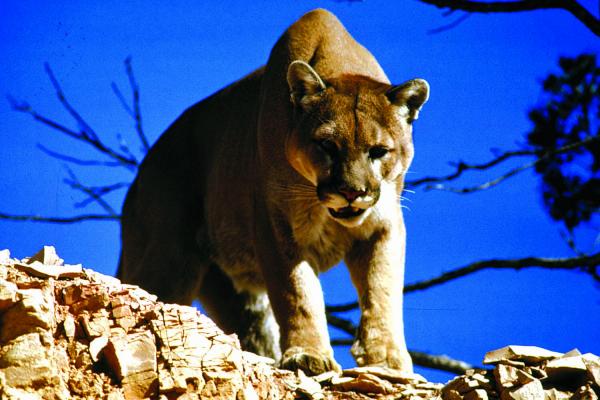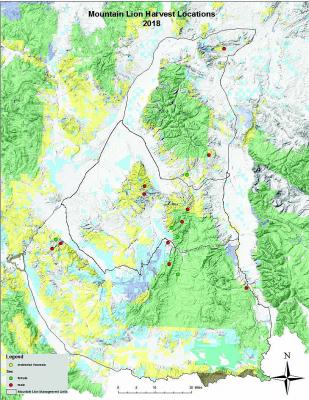Mountain lions in Madison County
Results of hunts show cats are widely distributed
ENNIS – According to Montana Fish, Wildlife and Parks biologist Dean Waltee, hunters harvested 18 mountain lions across his management area during the 2018-19 season: Seventeen were legal harvests and one was an incidental harvest of a female following the female harvest quota having been met. This was the first documented incidental lion harvest across my area since 2016.
Of the 18 harvests, four (two male, two female) occurred in the Tobacco Roots Management Unit, seven (five male, two female) occurred in the Greenhorn/Ruby/Sweetwater Hills Management Unit, and seven (five male, two female) occurred in the Gravelly/Centennial/Blacktail Management Unit. (See map)
Teeth were collected from all 18 harvested lions and will be sent to Madson’s Laboratory for aging, data not likely to be available until spring 2020.
All age classes were represented among males. No harvests of 1-2 year old females occurred during the 2017-18 season.
Season overview
Of the 17 legal hunter-harvests
• 71 percent were by resident hunters;
• 56 percent of resident harvests were by Madison, Beaverhead, and Jefferson County residents;
• 100 percent were taken during the chase season;
• 100 percent were pursued using dogs; and
• 47 percent were harvested on publicly accessible public lands while 53 percent were harvested on private or land-locked public parcels.
Hunters who harvested a lion reported spending an average of 3.5 days afield prior to harvesting a lion—compared to 5.5 last year and a long-term average (LTA) of 4.3.
Hunters reported observing 0.8 lions/tracks per day afield—compared to 0.7 last year and a LTA of 0.6. Lion/track encounters per day afield have decreased 50 percent since the 2014-15 season, when hunters reported observing 1.6 lions/tracks per day afield. However, that level of observation was a 20-year high and was 2.6x the LTA. Hunters reported encountering 45 adults and 2 kittens. These data suggest a kitten to 100 adults ratio of 4.4—compared to 15.5 last year and a LTA of 13.0. I received one anecdotal report of high kitten occurrence from a local houndsman.
Tobacco Roots (HDs 320, 333)
Prior to the 2017-18 season, we recommended reducing the Tobacco Roots quota from six with a female sub-quota of two, to four with a female sub-quota of one.
This recommendation was based much on feedback from a majority of houndsmen indicating lion encounters had declined following a period of elevated harvest (27 known hunter, incidental, and conflict mortalities from 2013 through 2016) and a lower quota was warranted to maintain the current population. This perspective was seconded by several area landowners reporting reduced conflict over the past year.
The 2017-18 quota of four was met on January 13, with all harvests occurring on the north end of the mountain range. The 2018-19 quota did not fill in-spite of a relatively high number of days with recent snow-cover. The majority of feedback I received supported maintaining the current quotas for the 2019-20 season. Therefore, I did not recommend any quota changes.
Greenhorn/Ruby/Sweetwater Hills (HDs 322, 326, 330)
Prior to the 2014-15 season, we recommended raising the quota from four with a female sub-quota of two, to six with a female sub-quota of two. This recommendation was based much on feedback from big game hunters, landowners, local residents, and majority houndsmen that increased harvest was desired to manage increasing lion populations.
For the same reasons and because increased access to the western portions of the management units was expected to geographically expand harvest, the quota was increased to seven with a female sub-quota of two.
During the 2018-19 season, the quota filled on January 29. Increased harvest within the Sweetwater Hills portion of this management unit was not realized during the 2018-19 season. I recently received one request to lower this quota, but I did not recommend any changes to this quota for the 2019-2020 season.
Gravelly/Centennial/Blacktail (HDs 323, 324, 325, 327)
Prior to the 2014-15 season, we recommended raising the quota from four with a female sub-quota of two, to six with a female sub-quota of two.
This recommendation was based much on feedback from big game hunters, landowners, local residents, and majority houndsmen that increased harvest was desired to manage increasing lion populations. For the same reasons and because increased access to the western portions of the management units was expected to geographically expand harvest, the quota was increased to seven with a female sub-quota of two.
During the 2018-19 season, the quota filled on January 8. Increased harvest within the Blacktail portion of this management unit was realized during the 2018-19 season. I recently received one request to lower this quota, but I did not recommend any changes to this quota for the 2019-2020 season.
Anyone with questions about mountain lion management or thoughts regarding future harvest is urged to contact Waltee at 406-842-7407.


